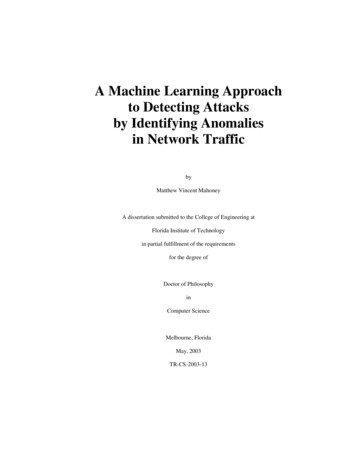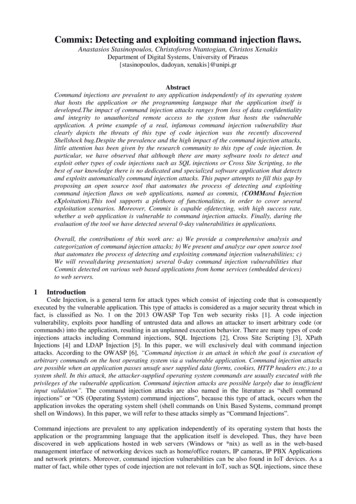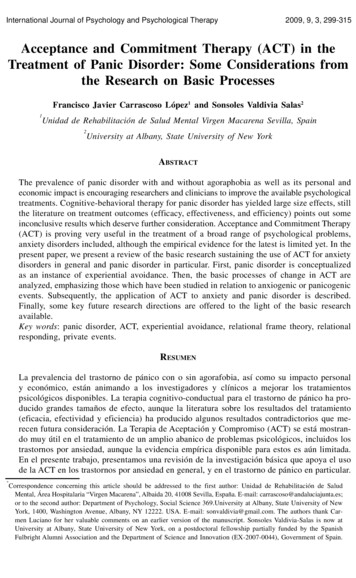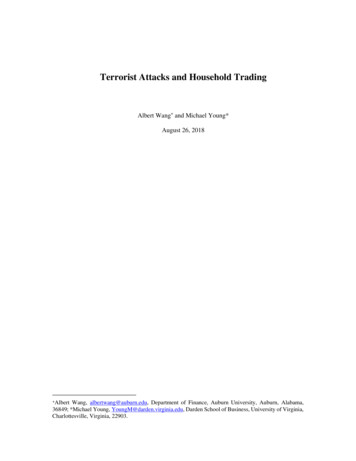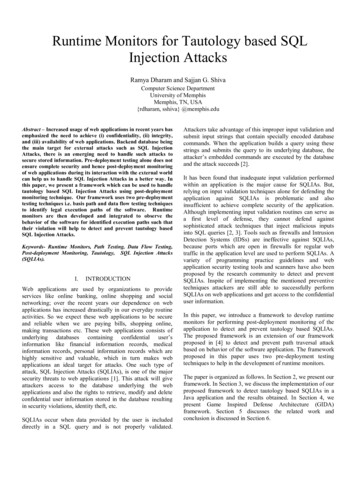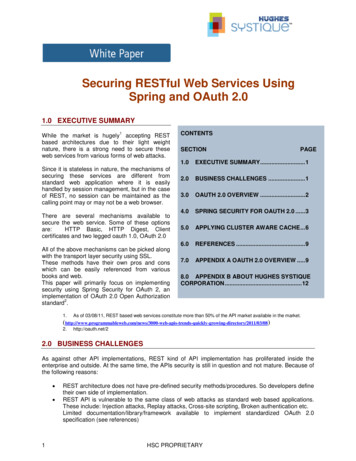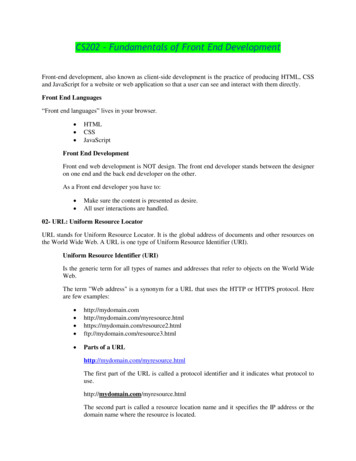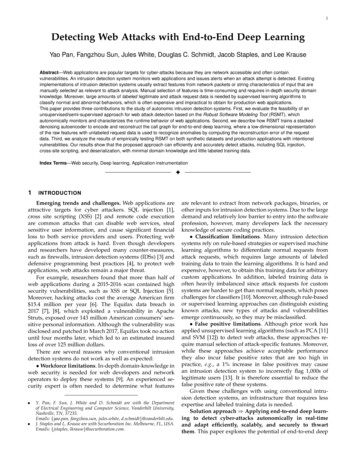
Transcription
1Detecting Web Attacks with End-to-End Deep LearningYao Pan, Fangzhou Sun, Jules White, Douglas C. Schmidt, Jacob Staples, and Lee KrauseAbstract—Web applications are popular targets for cyber-attacks because they are network accessible and often containvulnerabilities. An intrusion detection system monitors web applications and issues alerts when an attack attempt is detected. Existingimplementations of intrusion detection systems usually extract features from network packets or string characteristics of input that aremanually selected as relevant to attack analysis. Manual selection of features is time-consuming and requires in-depth security domainknowledge. Moreover, large amounts of labeled legitimate and attack request data is needed by supervised learning algorithms toclassify normal and abnormal behaviors, which is often expensive and impractical to obtain for production web applications.This paper provides three contributions to the study of autonomic intrusion detection systems. First, we evaluate the feasibility of anunsupervised/semi-supervised approach for web attack detection based on the Robust Software Modeling Tool (RSMT), whichautonomically monitors and characterizes the runtime behavior of web applications. Second, we describe how RSMT trains a stackeddenoising autoencoder to encode and reconstruct the call graph for end-to-end deep learning, where a low-dimensional representationof the raw features with unlabeled request data is used to recognize anomalies by computing the reconstruction error of the requestdata. Third, we analyze the results of empirically testing RSMT on both synthetic datasets and production applications with intentionalvulnerabilities. Our results show that the proposed approach can efficiently and accurately detect attacks, including SQL injection,cross-site scripting, and deserialization, with minimal domain knowledge and little labeled training data.Index Terms—Web security, Deep learning, Application instrumentationF1INTRODUCTIONEmerging trends and challenges. Web applications areattractive targets for cyber attackers. SQL injection [1],cross site scripting (XSS) [2] and remote code executionare common attacks that can disable web services, stealsensitive user information, and cause significant financialloss to both service providers and users. Protecting webapplications from attack is hard. Even though developersand researchers have developed many counter-measures,such as firewalls, intrusion detection systems (IDSs) [3] anddefensive programming best practices [4], to protect webapplications, web attacks remain a major threat.For example, researchers found that more than half ofweb applications during a 2015-2016 scan contained highsecurity vulnerabilities, such as XSS or SQL Injection [5].Moreover, hacking attacks cost the average American firm 15.4 million per year [6]. The Equifax data breach in2017 [7], [8], which exploited a vulnerability in ApacheStruts, exposed over 143 million American consumers’ sensitive personal information. Although the vulnerability wasdisclosed and patched in March 2017, Equifax took no actionuntil four months later, which led to an estimated insuredloss of over 125 million dollars.There are several reasons why conventional intrusiondetection systems do not work as well as expected: Workforce limitations. In-depth domain-knowledge inweb security is needed for web developers and networkoperators to deploy these systems [9]. An experienced security expert is often needed to determine what features Y. Pan, F. Sun, J. White and D. Schmidt are with the Departmentof Electrical Engineering and Computer Science, Vanderbilt University,Nashville, TN, 37235.Emails: {yao.pan, fangzhou.sun, jules.white, d.schmidt}@vanderbilt.edu.J. Staples and L. Krause are with Securboration Inc. Melbourne, FL, USA.Emails: {jstaples, lkrause}@securboration.com.are relevant to extract from network packages, binaries, orother inputs for intrusion detection systems. Due to the largedemand and relatively low barrier to entry into the softwareprofession, however, many developers lack the necessaryknowledge of secure coding practices. Classification limitations. Many intrusion detectionsystems rely on rule-based strategies or supervised machinelearning algorithms to differentiate normal requests fromattack requests, which requires large amounts of labeledtraining data to train the learning algorithms. It is hard andexpensive, however, to obtain this training data for arbitrarycustom applications. In addition, labeled training data isoften heavily imbalanced since attack requests for customsystems are harder to get than normal requests, which poseschallenges for classifiers [10]. Moreover, although rule-basedor supervised learning approaches can distinguish existingknown attacks, new types of attacks and vulnerabilitiesemerge continuously, so they may be misclassified. False positive limitations. Although prior work hasapplied unsupervised learning algorithms (such as PCA [11]and SVM [12]) to detect web attacks, these approaches require manual selection of attack-specific features. Moreover,while these approaches achieve acceptable performancethey also incur false positive rates that are too high inpractice, e.g., a 1% increase in false positives may causean intrusion detection system to incorrectly flag 1,000s oflegitimate users [13]. It is therefore essential to reduce thefalse positive rate of these systems.Given these challenges with using conventional intrusion detection systems, an infrastructure that requires lessexpertise and labeled training data is needed.Solution approach Applying end-to-end deep learning to detect cyber-attacks autonomically in real-timeand adapt efficiently, scalably, and securely to thwartthem. This paper explores the potential of end-to-end deep
2learning [14] in intrusion detection systems. Our approachapplies deep learning to the entire process from featureengineering to prediction, i.e., raw input is fed into thenetwork and high-level output is generated directly. There isthus no need for users to select features and construct largelabeled training sets.We empirically evaluate how well an unsupervised/semi-supervised learning approach based on end-to-enddeep learning detects web attacks. Our work is motivatedby the success deep learning has achieved in computervision [15], speech recognition [16], and natural languageprocessing [17]. In particular, deep learning is not onlycapable of classification, but also automatically extractingfeatures from high dimensional raw input.Our deep learning approach is based on the RobustSoftware Modeling Tool (RSMT) [18], which is a late-stage(i.e., post-compilation) instrumentation-based toolchain targeting languages that run on the Java Virtual Machine (JVM).RSMT is a general-purpose tool that extracts arbitrarily finegrained traces of program execution from running software,which is applied in this paper to detect intrusions at runtimeby extracting call traces in web applications. Our approachapplies RSMT in the following steps:1. During an unsupervised training epoch, traces generated by test suites are used to learn a model of correctprogram execution with a stacked denoising autoencoder,which is a symmetric deep neural network trained to havetarget value equal to a given input value [19].2. A small amount of labeled data is then used tocalculate reconstruction error and establish a threshold todistinguish normal and abnormal behaviors.3. During a subsequent validation epoch, traces extracted from a live application are classified using previously learned models to determine whether each trace isindicative of normal or abnormal behavior.A key contribution of this paper is the integration ofautonomically runtime behavior monitoring and characterization of web applications with end-to-end deep learningmechanisms, which generate high-level output directly fromraw feature input.The remainder of this paper is organized as follows:Section 2 summarizes the key research challenges we areaddressing in our work; Section 3 describes the structure and functionality of the Robust Software Modeling Tool(RSMT); Section 4 explains our approach for web attackdetection using unsupervised/semi-supervised end-to-enddeep learning and the stacked denoising autoencoder; Section 5 empirically evaluates the performance of our RSMTbased intrusion detection system on representative webapplications; Section 6 compares our work with relatedweb attack detection techniques; and Section 7 presentsconcluding remarks.2R ESEARCH C HALLENGESThis section describes the key research challenges we address and provides cross-references to later portions of thepaper that show how we applied RSMT to detect webattacks with end-to-end deep learning.Challenge 1: Comprehensive detection of various typesof attacks that have significantly different characteristics.Different types of web attacks, such as SQL injection, crosssite scripting, remote code execution and file inclusion vulnerabilities, use different forms of attack vector and exploitdifferent vulnerabilities inside web applications. These attacks therefore often exhibit completely different characteristics. For example, SQL injection targets databases, whereasremote code execution targets file systems. Conventionalintrusion detection systems [2], [20], however, are oftendesigned to detect only one type of attack. For example,a grammar-based analysis that works on SQL injectiondetection will not work on XSS. Section 3 describes howwe applied RSMT to characterize the normal behaviors anddetect different types of attacks comprehensively.Challenge 2: Minimizing monitoring overhead. Staticanalysis approaches that analyze source code and search forpotential flaws suffer from various drawbacks, includingvulnerability to unknown attacks and the need for sourcecode access. An alternative is to apply dynamic analysisby instrumenting applications. However, instrumentationinvariably incurs monitoring overhead [21], which may degrade web application throughput and latency, as describedin Section 5.3. Section 3.2 explores techniques RSMT appliesto minimize the overhead of monitoring and characterizingapplication runtime behavior.Challenge 3: Addressing the labeled training dataproblem in supervised learning. Machine learning-basedintrusion detection systems rely on labeled training datato learn what should be considered normal and abnormalbehaviors. Collecting this labeled training data can be hardand expensive in large scale production web applicationssince labeling data requires extensive human effort and it isdifficult to cover all the possible cases. For example, normalrequest training data can be generated with load testingtools, web crawlers, or unit tests. If the application hasvulnerabilities, however, then the generated data may alsocontain some abnormal requests, which can undermine theperformance of supervised learning approaches.Abnormal training data is even harder to obtain [22], e.g.,it is hard to know what types of vulnerabilities a systemhas and what attacks it will face. Even manually creatingattack requests targeted for a particular application maynot cover all scenarios. Moreover, different types of attackshave different characteristics, which makes it hard for supervised learning methods to capture what attack requestsshould look like. Although supervised learning approachesoften distinguish known attacks effectively, they may missnew attacks and vulnerabilities that emerge continuously,especially when web applications frequently depend onmany third-party packages [8]. Section 4.3 describes howwe applied an autoencoder-based unsupervised learningapproach to resolve the labeled training data problem.Challenge 4: Developing intrusion detection systemswithout requiring users to have extensive web securitydomain knowledge. Traditional intrusion detection systemsapply rule-based approach where users must have domainspecific knowledge in web security. Experienced security experts are thus needed to determine what feature is relevantto extract from network packages, binaries or other input forintrusion detection systems. This feature selection processcan be tedious, error-prone, and time-consuming, such thateven experienced engineers often rely on repetitive trialand-error processes. Moreover, with quick technology re-
3fresh cycles, along with the continuous release of new toolsand packages, even web security experts may struggle tokeep pace with the latest vulnerabilities. Section 4.1 and 4.2describe how we applied RSMT to build intrusion detectionsystems with “featureless” approaches that eliminated thefeature engineering step and directly used high-dimensionalrequest traces data as input.3 T HE S TRUCTURE AND F UNCTIONALITY OF THER OBUST S OFTWARE M ODELING TOOL (RSMT)This section describesthe structure and functionality of theRobust Software Modeling Tool (RSMT), which we developedto autonomically monitor and characterize the runtime behavior of web applications, as shown in Figure 8. AfterFig. 1. The Workflow and Architecture of RSMT’s Online Monitoring andDetection Systemgiving a brief overview of RSMT, this section focuses onRSMT’s agent and agent server components and explainshow these components address Challenge 1 detection different types of attacks) and Challenge 2 (minimizing instrumentation overhead) summarized in Section 2. Section 4then describes RSMT’s learning backend components andexamines the challenges they address.3.1automated (e.g., test suites and fuzzers) inputs. The manifestation of one or more stimuli results in the executionof various application behaviors. RSMT attaches an agentand embeds lightweight shims into an application (b). Theseshims do not affect the functionality of the software, butinstead serve as probes that allow efficient examination ofthe inner workings of software applications. The eventstracked by RSMT are typically control flow-oriented, butdataflow-based analysis is also possible.As the stimuli drive the system, the RSMT agent intercepts event notifications issued by the shim instructions.These notifications are used to construct traces of behaviorthat are subsequently transmitted to a separate trace management process (c). This process aggregates traces over asliding window of time (d) and converts these traces into“bags” of features (e). RSMT uses feature bags to enactonline strategies (f), which involve two epochs: (1) During atraining epoch, where RSMT uses these traces (generated bytest suites) to learn a model of correct program execution,and (2) During a subsequent validation epoch, where RSMTclassifies traces extracted from a live application using previously learned models to determine whether each trace isindicative of normal or abnormal behavior.Figure 8 also shows the three core components ofRSMT’s architecture, which include (1) an application, towhich the RSMT agent is attached, (2) an agent server, whichis responsible for managing data gathered from variousagents, and (3) a machine learning backend, which is usedfor training various machine learning models and validatingtraces. This architecture is scalable to accommodate arbitrarily large and complex applications, as shown in Figure 2.For example, a large web application may contain multipleOverview of RSMTAs discussed in Section 2, different attacks have different characteristics and traditional feature engineering approaches lack a unified solution for all types of attacks.RSMT bypasses these attack vectors and instead capturesthe low-level call graph. It assumes that no matter what theattack type is (1) some methods in the server that shouldnot be accessed are invoked and/or (2) the access pattern isstatistically different than the legitimate traffic.RSMT operates as a late-stage (post-compilation)instrumentation-based toolchain targeting languages thatrun on the Java Virtual Machine (JVM). It extracts arbitrarilyfine-grained traces of program execution from running software and constructs its models of behavior by first injectinglightweight shim instructions directly into an application binary or bytecode. These shim instructions enable the RSMTruntime to extract features representative of control and dataflow from a program as it executes, but do not otherwiseaffect application functionality.Figure 8 shows the high-level workflow of RSMT’s webattack monitoring and detection system. This system isdriven by one or more environmental stimuli (a), which areactions transcending process boundaries that can be broadlycategorized as manual (e.g., human interaction-driven) orFig. 2. The Scalability of RSMTcomponents, where each component can be attached witha different agent. When the number of agents increases, asingle agent server may be overwhelmed by requests fromagents. Multiple agent servers can therefore be added andagent requests can then be directed to different agent serversusing certain partitioning rules.It is also possible to scale the machine learning backend,e.g., by deploying machine learning training and testingengine on multiple servers. An application generally comprises multiple tasks. For example, the tasks in a webforum service might be init, registerNewUser, createThread,and createPost. Machine learning models are built at the taskgranularity. Different machine learning backends store andprocess different models.
43.2The RSMT AgentProblem to resolve. To monitor and characterize web application runtime behavior, a plugin program is neededto instrument the web application and record necessaryruntime information. This plugin program should requireminimum human intervention to avoid burdening developers with low-level application behavior details. Likewise,instrumentation invariably incurs performance overhead,but this overhead should be minimized, otherwise web application throughput and latency will be unduly degraded.Solution approach. To address the problem of instrumentation with minimum developer burden and performance overhead, the RSMT agent captures features that arerepresentative of application behavior. This agent defines aclass transformation system that creates events to generalizeand characterize program behavior at runtime. This transformation system is plugin-based and thus extensible, e.g.,it includes a range of transformation plugins providing instrumentation support for extracting timing, coarse-grained(method) control flow, fine-grained (branch) control flow,exception flow, and annotation-driven information capture.For example, a profiling transformer could inject ultralightweight instructions to store the timestamps when methods are invoked. A trace transformer could add methodEnter() and methodExit() calls to construct a control flowmodel. Each transformation plugin conforms to a commonAPI. This common API can be used to determine whetherthe plugin can transform a given class, whether it cantransform individual methods in that class, and whether itshould actually perform those transformations if it is able.We leverage RSMT’s publish-subscribe (pub/sub) mechanism to (1) rapidly disseminate events by instrumentedcode and (2) subsequently capture these events via eventlisteners that can be registered dynamically at runtime.RSMT’s pub-sub mechanism is exposed to instrumentedbytecode via a proxy class that contains various static methods.1 In turn, this proxy class is responsible for calling various listeners that have been registered to it. The followingevent types are routed to event listeners: Registration events are typically executed once permethod in each class as its clinit (class initializer)method is executed. These events are typically consumed(not propagated) by the listener proxy. Control flow events are issued just before or just after aprogram encounters various control flow structures. Theseevents typically propagate through the entire listener delegation tree. Annotation-driven events are issued when annotatedmethods are executed. These events propagate to the offlineevent processing listener children.The root listener proxy is called directly from instrumented bytecode and delegates event notifications to an error handler, which gracefully handles exceptions generatedby child nodes. Specifically, the error handler ensures thatall child nodes receive a notification regardless of whetherthat notification results in the generation of an exception(as is the case when a model validator detects unsafe behavior). The error handler delegates to the following model1. We use static methods since calling a Java static method is up to 2xfaster than calling a Java instance method.construction/validation subtrees: (1) the online model construction/validation subtree performs model constructionand verification in the current thread of execution (i.e., onthe critical path) and (2) the offline model construction/validation subtree converts events into a form can be storedasynchronously with a (possibly remote) instance of Elasticsearch [23], which is an open-source search and analyticsengine that provides a distributed real-time document store.To address Challenge 1 (minimizing the overhead ofmonitoring and charactering application runtime behavior)described in Section 2, RSMT includes a dynamic filteringmechanism. We analyzed the method call patterns andobserved that most method calls are lightweight and occurin a small subset of nodes in the call graph. By identifyinga method as being called frequently and having a significantly larger performance impact, we can disable eventsissued from it entirely or reduce the number of events itproduces (thereby improving performance). These observations, along with a desire for improved performance, motivated the design of RSMT’s dynamic filtering mechanism.To enable filtering, each method in each class is associated with a new static field added to that class during theinstrumentation process. The value of the field is an objectused to filter methods before they make calls to the runtimetrace API. This field is initialized in the constructor and ischecked just before any event would normally be issued todetermine if the event should actually occur.To characterize feature vector abilities to reflect application behaviors, we added an online model builder andmodel validator to RSMT. The model builder constructs twoviews of software behavior: a call graph (used to quicklydetermine whether a transition is valid) and a call tree (usedto determine whether a sequence of transitions is valid).The model validator is a closely related component thatcompares current system behavior to an instance of a modelassumed to represent correct behavior.Fig. 3. Call Graph (L) and Call Tree (R) Constructed for a Simple Seriesof Call Stack TracesFigures 4 and 5 demonstrate the complexity of thegraphs we have seen. Each directed edge in a call graphconnects a parent method (source) to a method called by theparent (destination). Call graph edges are not restricted wrtforming cycles. Suppose the graph in Figure 3 representedcorrect behavior. If we observed a call sequence e,a,x atruntime, we could easily tell that this was not a validexecution path because no a,x edge is present in the callgraph.Although the call graph is fast and simple to construct,it has shortcomings. For example, suppose a transitionsequence e,a,d,c,a is observed. Using the call graph, noneof these transition edges violated expected behavior. If we
5Fig. 4. Call Tree Generated for a Simple SQL Statement ParseFig. 5. Call Tree Generated for a Simple SQL Statement Parse (zoomedin on heavily visited nodes)account for past behavior, however, there is no c,a transitionoccurring after e,a,d. To handle these more complex cases, amore robust structure is needed. This structure is known asthe call tree, as shown in the right-hand side of Figure 3.Whereas the call graph falsely represents it as a validsequence, there is no path along sequence e,a,d,c,a in thecall tree (this requires two backtracking operations), so wedetermine that this behavior is incorrect. The call tree is nota tree in the structural sense. Rather, it is a tree in that eachbranch represents a possible execution path. If we followthe current execution trace to any node in the call tree, thecurrent behavior matches the expectation.Unlike a pure tree, the call tree does have self-referentialedges (e.g., the c,a edge in Figure 3) if recursion is observed.Using this structure is obviously more processor intensive than tracking behavior using a call graph. Section 5.3presents empirical evaluation of the performance overheadof the RSMT agent.3.3The RSMT Agent ServerProblem to resolve. A web application may comprise multiple components where multiple agents are attached. Likewise, there multiple instances of the application may run ondifferent physical hardware for scalability. It is importantfor agents to communicate effectively with our machinelearning backend to process collected traces, which requiressome means of mapping the task- and application-levelabstractions onto physical computing resources.Solution approach. To address the problem of mappingtask/application-level abstractions to physical computingresources, RSMT defines an agent server component. Thiscomponent receives traces from various agents, aligns themto an application architecture, maps application componentsto models of behavior, and pushes the trace to the correctmodel in a remote machine learning system that is architecture agnostic. The agent server exposes three different RESTAPIs, which are described below: A trace API, to which RSMT agents transmit executiontraces. This API provides the following functionality: (1) itallows an agent to register a recently launched JVM as acomponent in a previously defined architecture and (2) itallows an agent to push execution trace(s). An application management API, which is usefulfor defining and maintaining applications. It provides thefollowing functionality: (1) define/delete/modify an application, (2) retrieve a list of applications, and (3) transitioncomponents in an application from one state to another.This design affects how traces received from monitoringagents are handled. For example, in the IDLE state, traces arediscarded whereas in the TRAIN state they are conveyed to amachine learning backend that applies them incrementallyto build a model of expected behavior. In the VALIDATEstate, traces are compared against existing models and classified as normal or abnormal. A classification API, which monitors the health ofapplications. This API can be used to query the status of application components over a sliding window of time, whosewidth determines how far back in time traces are retrievedduring the health check and which rolls up into a summaryof all classified traces for an applications operation. The APIcan also be used to retrieve a JSON representation of thecurrent health of the application.4 U NSUPERVISED W EB ATTACK D ETECTION WITHE ND - TO -E ND D EEP L EARNINGThis section describes our unsupervised/semi-supervisedweb attack detection system that enhances the RSMT architectural components described in Section 3 with end-to-enddeep learning mechanisms [16], [24], which generate highlevel output directly from raw feature input. The RSMTcomponents covered in Section 3 provide feature inputfor the end-to-end deep learning mechanisms described inthis section, whose output indicates whether the request islegitimate or an attack. This capability addresses Challenge4 (developing intrusion detection systems without domainknowledge) summarized in Section 2.4.1Traces Collection with Unit TestsRSMT agent is responsible for collecting an application’sruntime trace. The collected traces include the program’sexecution path information, which is then used as the feature input for our end-to-end deep learning system. Belowwe discuss how the raw input data is represented.When a client sends a request to a web application, atrace a recorded with an RSMT agent. A trace is a sequenceof directed f-calls-g edges observed beginning after theexecution of a method. From a starting entry method A,we record call traces up to depth d. We record the numberof times each trace triggers each method to fulfill a requestfrom a client. For example, A calls B one time and A calls Band B calls C one time will be represented as: A-B: 2; B-C:1; A-B-C: 1. Each trace can be represented as a 1*N vector[2,1,1] where N is the number of different method calls.Our goal is, given the trace signature Ti {c1 , c2 , ., cn }produced in response to a client request Pi , determine if therequest is an attack request.
64.2Anomaly Detection with Deep LearningMachine learning approaches for detecting web attacks canbe categorized into two types: supervised learning andunsupervised learning.Supervised learning approaches (such as NaveBayes [25] and SVM [26]) work by calibrating a classifierwith a training dataset that consists of data labeled as eithernormal traffic or attack traffic. The classifier then classifiesthe incoming traffic as either normal data or an attackrequest. Two general types of problems arise when applyingsupervised approaches to detect web attacks: (1) classifierscannot handle new types of attacks that are not includedin the training dataset, as described in Challenge 3 (hard toobtain labeled training data) in Section 2 and (2) it is hardto get a large amount of labeled training data, as we havedescribed in Challenge 3 in Section 2.Unsupervised learning approaches (such as PrincipalComponent Analysis (PCA) [27] and autoencoder [19]) donot require labeled training datasets. They rely on the assumption that data can be embedded into a lower dimensional subspace in which normal instances and anomaliesappear significantly different. The idea is to apply dimension reduction techniques (such as PCA or autoencoders)for anomaly detection. PCA or autoencoders try to learn afunctio
Detecting Web Attacks with End-to-End Deep Learning Yao Pan, Fangzhou Sun, Jules White, Douglas C. Schmidt, Jacob Staples, and Lee Krause . Our results show that the proposed approach can efficiently and accurately detect attacks, including SQL injection, cross-site scripting, and deserialization, with minimal domain knowledge and little .


